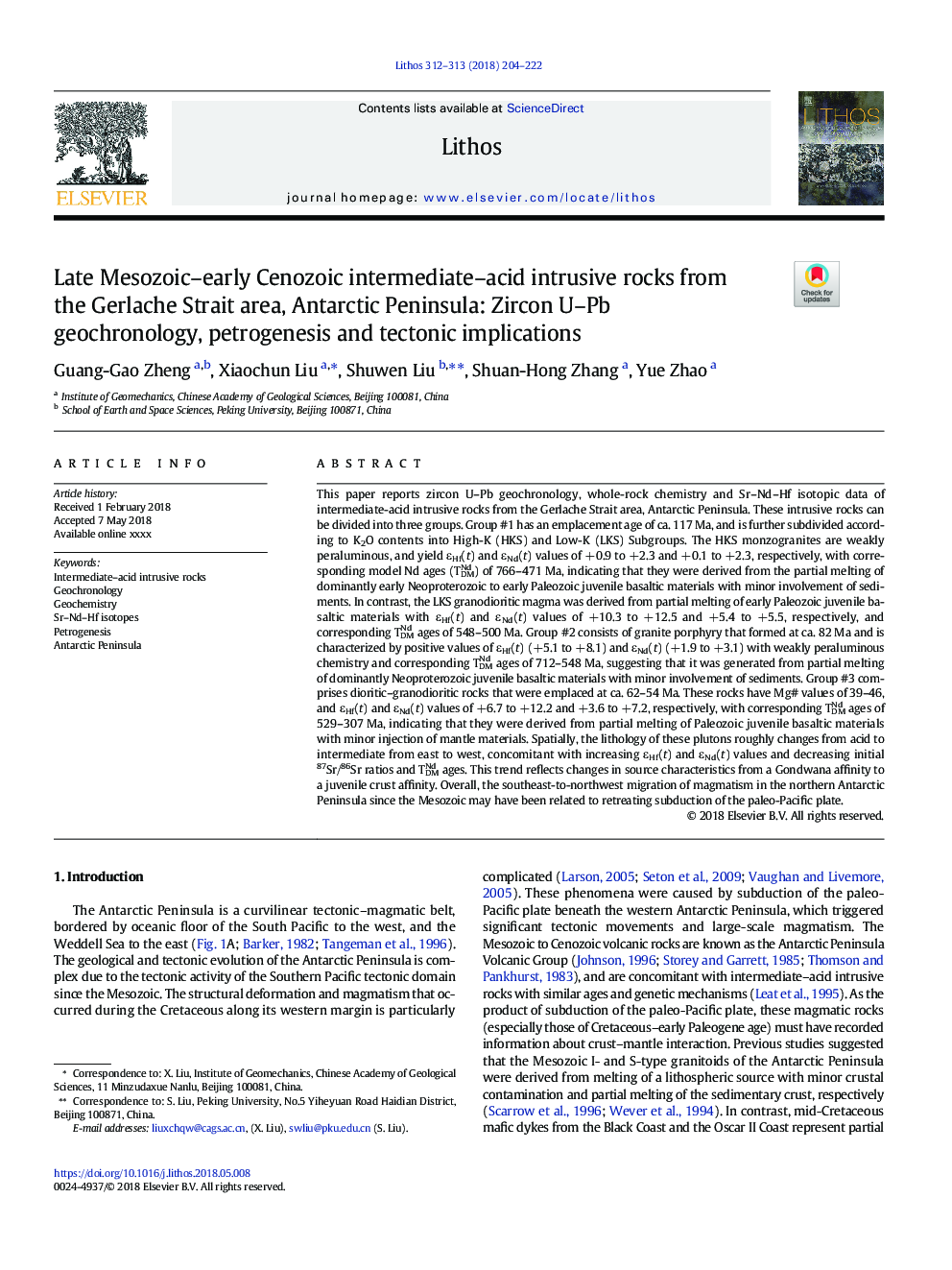| کد مقاله | کد نشریه | سال انتشار | مقاله انگلیسی | نسخه تمام متن |
|---|---|---|---|---|
| 8911590 | 1638618 | 2018 | 19 صفحه PDF | دانلود رایگان |
عنوان انگلیسی مقاله ISI
Late Mesozoic-early Cenozoic intermediate-acid intrusive rocks from the Gerlache Strait area, Antarctic Peninsula: Zircon U-Pb geochronology, petrogenesis and tectonic implications
دانلود مقاله + سفارش ترجمه
دانلود مقاله ISI انگلیسی
رایگان برای ایرانیان
کلمات کلیدی
موضوعات مرتبط
مهندسی و علوم پایه
علوم زمین و سیارات
ژئوشیمی و پترولوژی
پیش نمایش صفحه اول مقاله

چکیده انگلیسی
This paper reports zircon U-Pb geochronology, whole-rock chemistry and Sr-Nd-Hf isotopic data of intermediate-acid intrusive rocks from the Gerlache Strait area, Antarctic Peninsula. These intrusive rocks can be divided into three groups. Group #1 has an emplacement age of ca. 117â¯Ma, and is further subdivided according to K2O contents into High-K (HKS) and Low-K (LKS) Subgroups. The HKS monzogranites are weakly peraluminous, and yield εHf(t) and εNd(t) values of +0.9 to +2.3 and +0.1 to +2.3, respectively, with corresponding model Nd ages (TDMNd) of 766-471â¯Ma, indicating that they were derived from the partial melting of dominantly early Neoproterozoic to early Paleozoic juvenile basaltic materials with minor involvement of sediments. In contrast, the LKS granodioritic magma was derived from partial melting of early Paleozoic juvenile basaltic materials with εHf(t) and εNd(t) values of +10.3 to +12.5 and +5.4 to +5.5, respectively, and corresponding TDMNd ages of 548-500â¯Ma. Group #2 consists of granite porphyry that formed at ca. 82â¯Ma and is characterized by positive values of εHf(t) (+5.1 to +8.1) and εNd(t) (+1.9 to +3.1) with weakly peraluminous chemistry and corresponding TDMNd ages of 712-548â¯Ma, suggesting that it was generated from partial melting of dominantly Neoproterozoic juvenile basaltic materials with minor involvement of sediments. Group #3 comprises dioritic-granodioritic rocks that were emplaced at ca. 62-54â¯Ma. These rocks have Mg# values of 39-46, and εHf(t) and εNd(t) values of +6.7 to +12.2 and +3.6 to +7.2, respectively, with corresponding TDMNd ages of 529-307â¯Ma, indicating that they were derived from partial melting of Paleozoic juvenile basaltic materials with minor injection of mantle materials. Spatially, the lithology of these plutons roughly changes from acid to intermediate from east to west, concomitant with increasing εHf(t) and εNd(t) values and decreasing initial 87Sr/86Sr ratios and TDMNd ages. This trend reflects changes in source characteristics from a Gondwana affinity to a juvenile crust affinity. Overall, the southeast-to-northwest migration of magmatism in the northern Antarctic Peninsula since the Mesozoic may have been related to retreating subduction of the paleo-Pacific plate.
ناشر
Database: Elsevier - ScienceDirect (ساینس دایرکت)
Journal: Lithos - Volumes 312â313, July 2018, Pages 204-222
Journal: Lithos - Volumes 312â313, July 2018, Pages 204-222
نویسندگان
Guang-Gao Zheng, Xiaochun Liu, Shuwen Liu, Shuan-Hong Zhang, Yue Zhao,